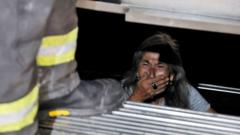Among the most harrowing situations was that of a woman in her seventies, who became trapped in a lift between floors, only to be rescued by local firefighters after she alerted them with desperate kicks and shouts. The desolate atmosphere was amplified by the dim glow of mobile phone flashlights, as passengers struggled for exit pathways in darkness.
The situation deteriorated rapidly; the Santiago Metro stated its evacuation process was completed in 90 minutes, yet the urgency of the matter was far from settled, as thousands of passengers remained stranded for hours. Although 150 extra buses were deployed, they failed to accommodate the influx of commuters, causing frustration at bus stops where long lines of anxious passengers formed. Many were left with no option but to walk home in the sweltering heat, complicating traffic further, as traffic lights were also rendered inoperable due to the blackout.
Local businesses suffered immensely, with small shops shutting down early and cafes unable to serve customers because of malfunctioning payment systems. Restaurants attempted to provide refuge for weary travelers, yet they were not spared from the chaos.
One notable incident unfolded in an amusement park, Fantasilandia, where dozens were stuck atop a rollercoaster until power could be restored. By nightfall, the government issued a state of emergency, enforcing a nighttime curfew to maintain order as soldiers patrolled the streets.
Despite the turmoil, some Chileans took a moment to appreciate a silver lining, sharing images of the clear night sky on social media, made visible by the absence of artificial lights. As the country grapples with the ramifications of this blackout, the resilience of its citizens is sure to shine through.
The situation deteriorated rapidly; the Santiago Metro stated its evacuation process was completed in 90 minutes, yet the urgency of the matter was far from settled, as thousands of passengers remained stranded for hours. Although 150 extra buses were deployed, they failed to accommodate the influx of commuters, causing frustration at bus stops where long lines of anxious passengers formed. Many were left with no option but to walk home in the sweltering heat, complicating traffic further, as traffic lights were also rendered inoperable due to the blackout.
Local businesses suffered immensely, with small shops shutting down early and cafes unable to serve customers because of malfunctioning payment systems. Restaurants attempted to provide refuge for weary travelers, yet they were not spared from the chaos.
One notable incident unfolded in an amusement park, Fantasilandia, where dozens were stuck atop a rollercoaster until power could be restored. By nightfall, the government issued a state of emergency, enforcing a nighttime curfew to maintain order as soldiers patrolled the streets.
Despite the turmoil, some Chileans took a moment to appreciate a silver lining, sharing images of the clear night sky on social media, made visible by the absence of artificial lights. As the country grapples with the ramifications of this blackout, the resilience of its citizens is sure to shine through.




















